新人教必修二Unit 2 Wildlife Protection 读写课
- 格式:pptx
- 大小:4.15 MB
- 文档页数:14
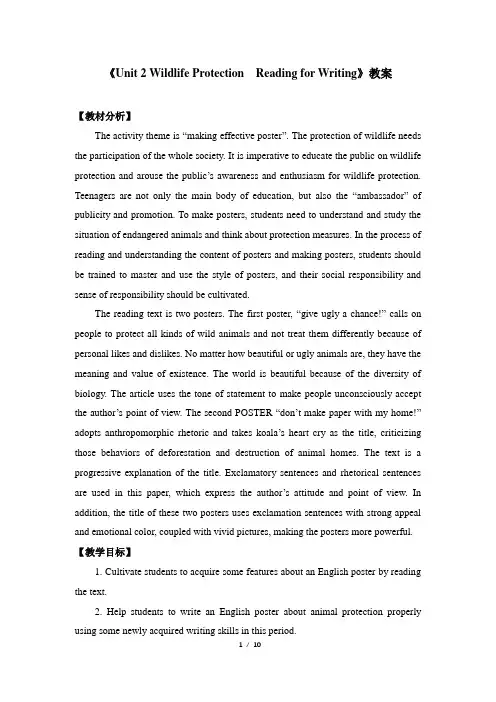
《Unit 2 Wildlife Protection Reading for Writing》教案【教材分析】The activity theme is “making effective poster”. The protection of wildlife needs the participation of the whole society. It is imperative to educate the public on wildlife protection and arouse the public’s awareness and enthusiasm for wildlife protection. Teenagers are not only the main body of education, but also the “ambassador”of publicity and promotion. To make posters, students need to understand and study the situation of endangered animals and think about protection measures. In the process of reading and understanding the content of posters and making posters, students should be trained to master and use the style of posters, and their social responsibility and sense of responsibility should be cultivated.The reading text is two posters. The first poster, “give ugly a chance!” calls on people to protect all kinds of wild animals and not treat them differently because of personal likes and dislikes. No matter how beautiful or ugly animals are, they have the meaning and value of existence. The world is beautiful because of the diversity of biology. The article uses the tone of statement to make people unconsciously accept the author’s point of view. The second POSTER “don’t make paper with my home!”adopts anthropomorphic rhetoric and takes koala’s heart cry as the title, criticizing those behaviors of deforestation and destruction of animal homes. The text is a progressive explanation of the title. Exclamatory sentences and rhetorical sentences are used in this paper, which express the author’s attitude and point of view. In addition, the title of these two posters uses exclamation sentences with strong appeal and emotional color, coupled with vivid pictures, making the posters more powerful. 【教学目标】1. Cultivate students to acquire some features about an English poster by reading the text.2. Help students to write an English poster about animal protection properly using some newly acquired writing skills in this period.3. Develop students’ writing and cooperating abilities.4. Strengthen students’ great interest in writing discourses.【教学重难点】1. Stimulate students to have a good understanding of how to write an English poster properly.2. Cultivate students to write an English poster properly and concisely.【教学过程】Step 1: Lead inDo you want to be a volunteer of a pet’s shelter? Why?Yes, I want to be a volunteer of it, because I want to help the pets, which are lovely and cute. I like them very much.Step 2: Read to discover details concerning the main details of the news report.I. Read the news report and then solve the questions below.1. Who started the rescue centre called the Small Friends Pet Shelter?A group of high school students and parents.2. What did the young people do in the shelter?Take care of animals.3. How do the young people think of their work?Worthwhile4. What help does the centre need?V olunteers’ time and love.II. Read the text again and then choose the best answer.1. What should we do when we protect the wildlife animals?A. Treat all the wild animals equally.B. Only pay attention to less cute animals.C. Pay attention to cute animals.D. Care about endangered wildlife animals.2. What’s the bad effect of cutting down billions of trees to make paper forhumans?A. Make a lot of animals homeless.B. Make a number of wildlife animals dying out.C. The animals’ habitat is being destroyed.D. All of them.【答案】ADCStep 3: Study the organization and language features.1. Read the passage more carefully and write down the outline of the text.2. Appreciate the complex sentences:1. The Small Friends Pet Shelter was started by a group of high school students and their parents when they started to see many pets (that were left behind after their families moved away).译文:当一些高中生和他们的父母看到在主人搬走后,____________ ___时,们建立了小朋友宠物收容所。
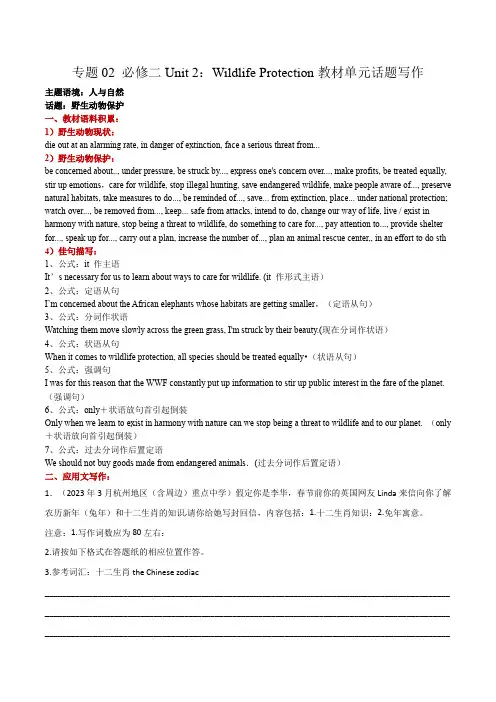
专题02 必修二Unit 2:Wildlife Protection教材单元话题写作主题语境:人与自然话题:野生动物保护一、教材语料积累:1)野生动物现状:die out at an alarming rate, in danger of extinction, face a serious threat from...2)野生动物保护:be concerned about.., under pressure, be struck by..., express one's concern over..., make profits, be treated equally, stir up emotions,care for wildlife, stop illegal hunting, save endangered wildlife, make people aware of..., preserve natural habitats, take measures to do..., be reminded of..., save... from extinction, place... under national protection; watch over..., be removed from..., keep... safe from attacks, intend to do, change our way of life, live / exist in harmony with nature, stop being a threat to wildlife, do something to care for..., pay attention to..., provide shelter for..., speak up for..., carry out a plan, increase the number of..., plan an animal rescue center,, in an effort to do sth 4)佳句描写:1、公式:it 作主语It’s necessary for us to learn about ways to care for wildlife. (it 作形式主语)2、公式:定语从句I’m concerned about the African elephants whose habitats are getting smaller,(定语从句)3、公式:分词作状语Watching them move slowly across the green grass, I'm struck by their beauty.(现在分词作状语)4、公式:状语从句When it comes to wildlife protection, all species should be treated equally•(状语从句)5、公式:强调句I was for this reason that the WWF constantly put up information to stir up public interest in the fare of the planet.(强调句)6、公式:only+状语放句首引起倒装Only when we learn to exist in harmony with nature can we stop being a threat to wildlife and to our planet. (only +状语放向首引起倒装)7、公式:过去分词作后置定语We should not buy goods made from endangered animals.(过去分词作后置定语)二、应用文写作:1.(2023年3月杭州地区(含周边)重点中学)假定你是李华,春节前你的英国网友Linda来信向你了解农历新年(兔年)和十二生肖的知识,请你给她写封回信,内容包括:1.十二生肖知识:2.免年寓意。
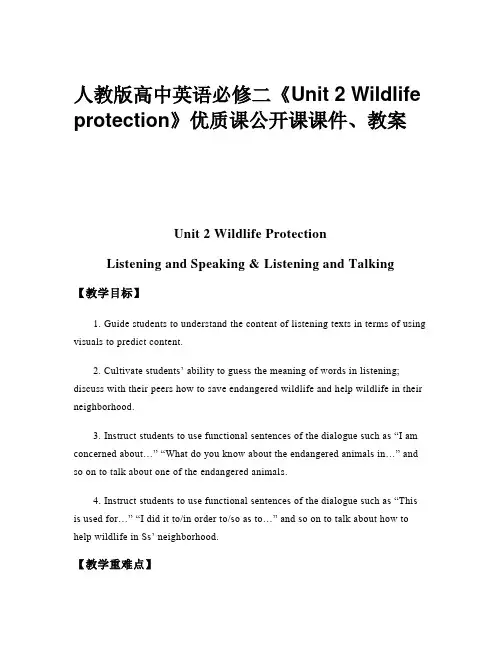
人教版高中英语必修二《Unit 2 Wildlife protection》优质课公开课课件、教案Unit 2 Wildlife ProtectionListening and Speaking & Listening and Talking【教学目标】1. Guide students to understand the content of listening texts in terms of using visuals to predict content.2. Cultivate students’ ability to guess the meaning of words in listening; discuss with their peers how to save endangered wildlife and help wildlife in their neighborhood.3. Instruct students to use functional sentences of the dialogue such as “I am concerned about…” “What do you know about the endangered animals in…” and so on to talk about one of the endangered animals.4. Instruct students to use functional sentences of the dialogue such as “This is used for…” “I did it to/in order to/so as to…” and so on to talk about how to help wildlife in Ss’ neighborhood.【教学重难点】1. Guide Ss to use the prediction strategy of reading pictures accurately to understand the content of listening texts;2. Guide Ss to express their opinions on how to participate in wildlife protection, and communicate with their peers about the living conditions and protection measures of wildlife in simple English.【教学过程】Part 1: Listening and SpeakingStep 1: Lead inThe teacher is advised to have a small talk about the topic:What messages do these posters share?Work in pairs and discuss. And then share your view after discussing.Step 2: PredictionAfter their small talk, the teacher can ask students to predict what the listening text is about by looking at the pictures.Some animals are endangered and why and how we can protect them from being extinct.Listening tip: use visuals to predict contentBefore listening, look at the pictures, videos, charts and other visuals to help you predict.Step 3: Summary of the main ideaPlay the audio which is about the dying wildlife on earth. And after finishing listening to the first part of the tape, the students need to solve the following task.Fill in the blanks while listening.Our planet’s ____________is dying out at an alarming rate. Between 150 and 200 species are becoming ___________ every day. This mass extinction is caused by hunting, habitat _________and pollution. We must make people aware of the problem and help_______ the endangered wildlife before it’s too late!After finishing the task above, the teacher plays the second part of the tape and after finishing listening, the students need to solve the following task.Listen and answer the following questions:1. How many elephants are killed on average every day?2. What did Prince William say about China?3. What does “change begins with you” mean?If you want things to change, you must change yourself first and not wait for others to be the first one to do something, you must be the number one to start to take the first action. In this way, we can change the world for the better.Step 4: Speaking ProjectIn pairs, discuss the questions, role play the example, and then talk about one of the animals in the photos below.1. What do you know about the animals in the photos?2. What is being done to help them?A: I’m concerned about the blue whales. What do you know about them?B: Well, I know that they’re being hunted and their number is gettingdramatically smaller, so they’re in danger of extinction. Blue whales needlarge and clear water habitats, so it’s difficult for them to adapt to the changes.A: That’s terrible. What measures are bein g taken to help them?B: The authorities are under pressure to make laws to ban illegal huntingwhales and tell people not to buy whales products.Part 2. Listening and TalkingStep1:Listen to the tape, for the first time, and then ask the students to solve the following tasks.Choose the right ending for each sentence.1. Binoculars ___________.2. Build bird feeders ___________.3. Use a bird field guide ___________.4. Put paper cut-outs on windows___________.A.in order to identify birdsB. so that birds do not crash into themC. to make sure that birds have enough foodD. are used for watching birds from far awayListen and answer the questions.1. Who are the teenagers?2. Where are they?3 What are they doing?4. Why are they doing it?Step 2: Listen again and use the phrases you hear to fill in the blanks. Expressing purposesThis is used for.../so as to…/in order to/He has done it sothat… /in order that…1. They got up early _____________search for wild birds.2. I’ve brought a field guide ___________we can look up the birds we see.3. My dad gave me the binoculars ______________we can see the birds better.4. Bird watching clubs clean up habitats build bird feeders, and put paper cut-outs on windows ________________protect birds.Step 3: Speaking ProjectWork in groups. Ask Ss to think of the wildlife in neighborhood and their needs. What can they do to care for them? Find out the solutions. Role play a dialogue with their partners.A: I often see wild cats and dogs in our neighborhood. Maybe we should do something to care for them.B: Should we put out bowls of food for them?C: Sure, and I think we could also put out boxes or other things for them, so that they can find shelter when it’s cold or wet outside.D: What else can we do for them?A: Why not raise money and form a pet’s homeless shelter where homeless pets can find a home and may be adopted by others.C: Sounds great. Let’s make a plan and try it.。
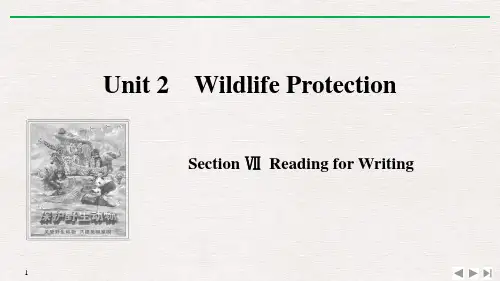
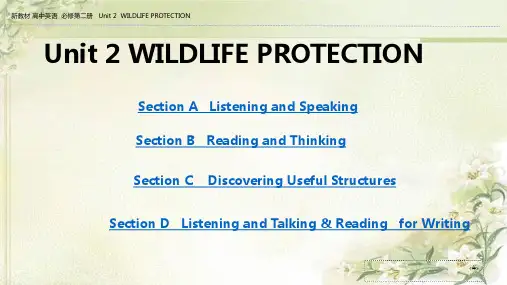

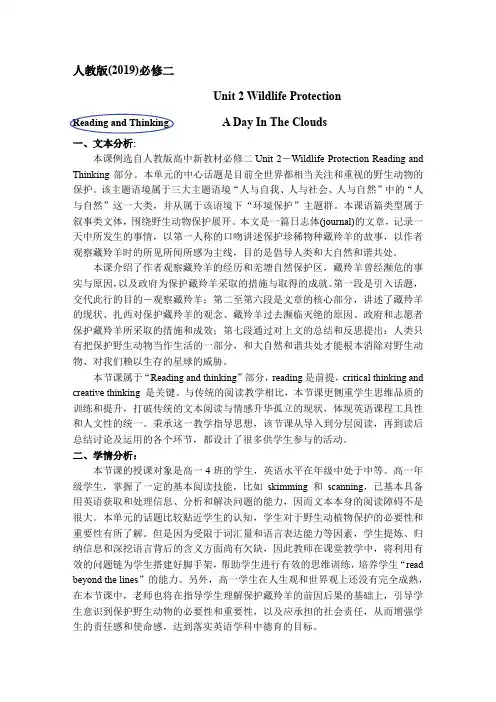
人教版(2019)必修二Unit 2 Wildlife ProtectionReading and Thinking A Day In The Clouds一、文本分析:本课例选自人教版高中新教材必修二Unit 2-Wildlife Protection Reading and Thinking部分。
本单元的中心话题是目前全世界都相当关注和重视的野生动物的保护。
该主题语境属于三大主题语境“人与自我、人与社会、人与自然”中的“人与自然”这一大类,并从属于该语境下“环境保护”主题群。
本课语篇类型属于叙事类文体,围绕野生动物保护展开。
本文是一篇日志体(journal)的文章,记录一天中所发生的事情,以第一人称的口吻讲述保护珍稀物种藏羚羊的故事,以作者观察藏羚羊时的所见所闻所感为主线,目的是倡导人类和大自然和谐共处。
本课介绍了作者观察藏羚羊的经历和羌塘自然保护区,藏羚羊曾经濒危的事实与原因,以及政府为保护藏羚羊采取的措施与取得的成就。
第一段是引入话题,交代此行的目的-观察藏羚羊;第二至第六段是文章的核心部分,讲述了藏羚羊的现状、扎西对保护藏羚羊的观念、藏羚羊过去濒临灭绝的原因、政府和志愿者保护藏羚羊所采取的措施和成效;第七段通过对上文的总结和反思提出:人类只有把保护野生动物当作生活的一部分,和大自然和谐共处才能根本消除对野生动物、对我们赖以生存的星球的威胁。
本节课属于“Reading and thinking”部分,reading是前提,critical thinking and creative thinking 是关键。
与传统的阅读教学相比,本节课更侧重学生思维品质的训练和提升,打破传统的文本阅读与情感升华孤立的现状,体现英语课程工具性和人文性的统一。
秉承这一教学指导思想,该节课从导入到分层阅读,再到读后总结讨论及运用的各个环节,都设计了很多供学生参与的活动。
二、学情分析:本节课的授课对象是高一4班的学生,英语水平在年级中处于中等。
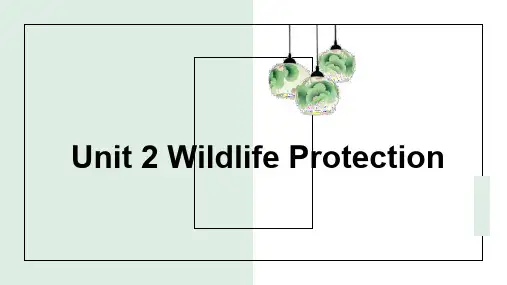

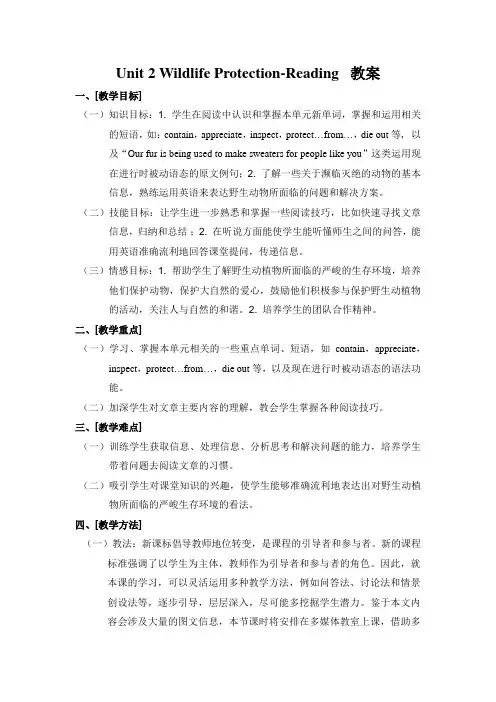
Unit 2 Wildlife Protection-Reading 教案一、[教学目标](一)知识目标:1. 学生在阅读中认识和掌握本单元新单词,掌握和运用相关的短语,如:contain,appreciate,inspect,protect…from…,die out等,以及“Our fur is being used to make sweaters for people like you”这类运用现在进行时被动语态的原文例句;2. 了解一些关于濒临灭绝的动物的基本信息,熟练运用英语来表达野生动物所面临的问题和解决方案。
(二)技能目标:让学生进一步熟悉和掌握一些阅读技巧,比如快速寻找文章信息,归纳和总结;2. 在听说方面能使学生能听懂师生之间的问答,能用英语准确流利地回答课堂提问,传递信息。
(三)情感目标:1.帮助学生了解野生动植物所面临的严峻的生存环境,培养他们保护动物,保护大自然的爱心,鼓励他们积极参与保护野生动植物的活动,关注人与自然的和谐。
2. 培养学生的团队合作精神。
二、[教学重点](一)学习、掌握本单元相关的一些重点单词、短语,如contain,appreciate,inspect,protect…from…,die out等,以及现在进行时被动语态的语法功能。
(二)加深学生对文章主要内容的理解,教会学生掌握各种阅读技巧。
三、[教学难点](一)训练学生获取信息、处理信息、分析思考和解决问题的能力,培养学生带着问题去阅读文章的习惯。
(二)吸引学生对课堂知识的兴趣,使学生能够准确流利地表达出对野生动植物所面临的严峻生存环境的看法。
四、[教学方法](一)教法:新课标倡导教师地位转变,是课程的引导者和参与者。
新的课程标准强调了以学生为主体,教师作为引导者和参与者的角色。
因此,就本课的学习,可以灵活运用多种教学方法,例如问答法、讨论法和情景创设法等,逐步引导,层层深入,尽可能多挖掘学生潜力。
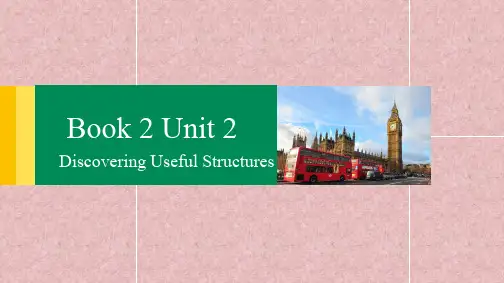
人教版高中英语必修第二册《Unit2Wildlifeprotection》说课稿一、教材简介《Unit2Wildlifeprotection》是人教版高中英语必修第二册的一个单元,主要讲述了野生动物和环境保护的相关知识。
本单元以保护野生动物和生态环境为主题,通过阅读、听力、口语和写作等多种方式,培养学生对野生动植物及其保护的认知和关注,培养学生的环保意识和责任感,同时提高他们的英语学习能力。
二、教学目标1.知识目标:–学习并掌握关于野生动物和环境保护的重要词汇和短语;–了解不同动物的生态习性及其在生态平衡中的作用;–掌握相关语法知识,如宾语从句和感叹句的用法等。
2.能力目标:–通过阅读和听力训练,提高学生的英语阅读和听力能力;–培养学生的口语表达能力,能够用英语进行简单的交流和讨论;–培养学生的写作能力,能够撰写一篇关于野生动物保护的短文。
3.情感目标:–培养学生对野生动物及其保护的兴趣和关注;–培养学生的环保意识和责任感,增强对自然环境的保护意识;–培养学生的合作和沟通能力,提高他们的团队意识。
三、教学重点和难点1.教学重点:–通过阅读和听力训练,提高学生的英语阅读和听力能力;–掌握相关的词汇、短语和句型,提高学生的语言运用能力;–启发学生的思维,培养他们的观察能力和批判思维能力。
2.教学难点:–帮助学生理解文章中的难点词汇和句子,提高他们的阅读理解能力;–引导学生进行口语表达和写作练习,提高他们的英语交际和写作能力。
四、教学准备1.教材:人教版高中英语必修第二册2.多媒体设备:投影仪、电脑、音响设备3.教学资源:单词卡片、图片、教学提纲、学生作品展示板五、教学过程1. 导入(10分钟)•利用图片和视频等多媒体形式,引入野生动物保护的话题,激发学生的学习兴趣。
•提问学生对野生动物保护的了解和想法,引导他们思考野生动物保护的重要性。
2. 预习导入(10分钟)•让学生在课前阅读Unit 2中的两篇阅读材料,了解关于大熊猫和海洋动物保护的内容。